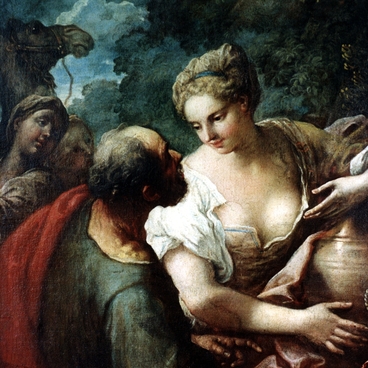Everyday life painting was one of the leading genres in the 17th-century Holland. Sebastian Heemskerk, a painter who was born in Amsterdam and worked there afterwards; he was a recognized artist in depicting genre scenes.
Heemskerk’s art was full of cheerful humor. The characters in most of his paintings were somewhat gruff commoners. In his works he revealed skilfully the theme of everyday life and manners of the Dutch poor. His painting titled “The Sick Man” is no exception.
Next to the frail protagonist and at the foot of his bed are several characters who are worried about the sick man. A monk is sitting in front of him. But the priest’s detached posture does not make it clear whether he is really praying for the patient’s health or thinking about the eternal things.
The figures of the other characters form scenes unrelated to the main plot of the painting: in the center, with his back to the patient, a man in an unbuttoned suit on his stomach is standing shakily on his feet, raising a glass. On the left is a group of people trying to stop him, among whom the best visible figure is a woman with her hands raised in prayer. She is saying something to a drunken brawler. Between them is the kneeling figure of a man. It is not clear what he is asking the Almighty for — for the health of the sick or for the appeasement of a raging alcoholic. The characters on the right do not seem to participate in what is happening and are living their own lives.
The skull, the pestle, the dirt and garbage on the floor by the bedside of the sick person, the pot for the toilet — all these signs of everyday life in Heemskerk’s painting have moralistic and allegorical implications as is typical of the works of the Dutch school.
The genre art is a vivid and original phenomenon of Dutch painting, which introduced the poetry of man’s everyday concerns. By the middle of the 17th century, it had become dominant in art, raising the established routine to a social ideal. The main achievement of Dutch artists is the ability to present a genre scene in unity with its environment. The characters are depicted in their natural surroundings, in familiar interiors, which makes it possible to convey an intimate atmosphere of peaceful coziness. This is based on the developed system of tonal painting and realism as its method.
At the same time, the 17th-century Dutch paintings are not just simple impressions of reality. They are full of emblems, meanings, symbols and hints warning against dangerous pastimes and vices.
Heemskerk’s art was full of cheerful humor. The characters in most of his paintings were somewhat gruff commoners. In his works he revealed skilfully the theme of everyday life and manners of the Dutch poor. His painting titled “The Sick Man” is no exception.
Next to the frail protagonist and at the foot of his bed are several characters who are worried about the sick man. A monk is sitting in front of him. But the priest’s detached posture does not make it clear whether he is really praying for the patient’s health or thinking about the eternal things.
The figures of the other characters form scenes unrelated to the main plot of the painting: in the center, with his back to the patient, a man in an unbuttoned suit on his stomach is standing shakily on his feet, raising a glass. On the left is a group of people trying to stop him, among whom the best visible figure is a woman with her hands raised in prayer. She is saying something to a drunken brawler. Between them is the kneeling figure of a man. It is not clear what he is asking the Almighty for — for the health of the sick or for the appeasement of a raging alcoholic. The characters on the right do not seem to participate in what is happening and are living their own lives.
The skull, the pestle, the dirt and garbage on the floor by the bedside of the sick person, the pot for the toilet — all these signs of everyday life in Heemskerk’s painting have moralistic and allegorical implications as is typical of the works of the Dutch school.
The genre art is a vivid and original phenomenon of Dutch painting, which introduced the poetry of man’s everyday concerns. By the middle of the 17th century, it had become dominant in art, raising the established routine to a social ideal. The main achievement of Dutch artists is the ability to present a genre scene in unity with its environment. The characters are depicted in their natural surroundings, in familiar interiors, which makes it possible to convey an intimate atmosphere of peaceful coziness. This is based on the developed system of tonal painting and realism as its method.
At the same time, the 17th-century Dutch paintings are not just simple impressions of reality. They are full of emblems, meanings, symbols and hints warning against dangerous pastimes and vices.

